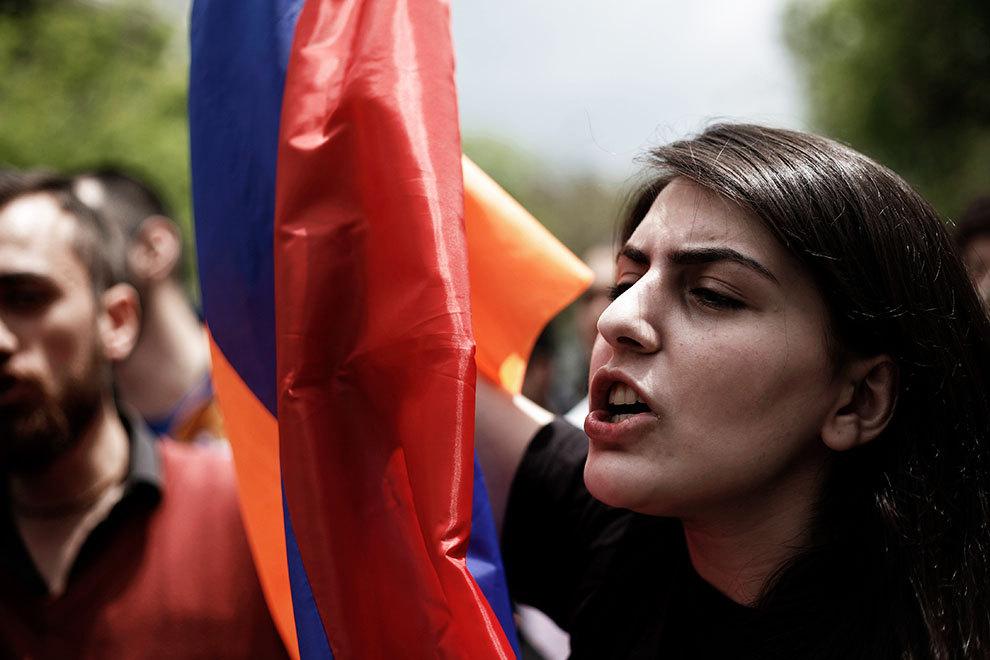Almost one hundred years ago, in the midst of the first world war, Ottoman officials forced Armenian people living in Anatolia to leave their homes and the area they had lived in for hundreds of years. Able-bodied men were killed, or forced into labour camps where most of them died. Women, children and old men were marched into the Syrian desert, where over half succumbed to marauders, disease or starvation.
To capture the enormity of the crime against the Armenians, the international lawyer Raphael Lemkin coined the term “genocide,” defining it as “a coordinated attempt to annihilate a national group.” The 1948 United Nations Convention on the Prevention and Punishment of the Crime of Genocide, inspired by Lemkin, defines genocide as “acts committed with the intent to destroy, in whole or in part, a national, ethnical, racial or religious group.” As listed in the Convention, these acts include not only killing and causing serious harm but also efforts to prevent births within the group and to forcibly transfer children to another group.
The existence of a UN Convention opposing genocide has not prevented genocide from occurring, of course. But the introduction of the concept into international law has given us a means of labelling crimes that we rightly regard as especially horrendous. Genocide, as the Australian lawyer Geoffrey Robertson writes in his recent book about the Armenians, An Inconvenient Genocide, is the worst kind of crime against humanity. Nevertheless, the term is surrounded by legal and philosophical uncertainties – doubts about its meaning and scope that are sometimes exploited by those who want to deny that a genocide has happened.
One of the problems is proving the existence of a genocidal intent. The Convention states that destruction of the group must be intended, but the existence of that intention is difficult to prove. Even the minutes of the notorious Wannsee Conference, where the Nazi leadership plotted “the final solution to the Jewish problem,” did not unambiguously state that the intent was to annihilate the Jewish population. Just as the difficulty of proving intent has undermined prosecutions for genocide in the International Criminal Court, so too it has aided the Turkish claim that their forebears did not commit genocide against the Armenians. The Armenians were deported, according to the official Turkish line, to prevent them from aiding Russia and undermining the Ottoman war effort. It was, it says, a measure of self-defence in a civil war.
Difficulties about intention reflect a more general philosophical difficulty concerning collective action. People can work together to bring about a result that no one intended or planned. The massacre of Tutsis by Hutus in Rwanda in 1994 was not ordered or directed by government or tribal leaders with a genocidal intent, and none of the Hutus who participated had a genocidal intention. No one can intend to do an act that is beyond his or her powers. But each perpetrator intended to kill Tutsis and worked with others to do so. Each knew that together they were bringing about the partial destruction of a group.
Many international lawyers have reasonably concluded that coordinated acts of destruction committed by people who know the result will be the annihilation or partial annihilation of a group are sufficient to establish a genocidal intent. This intention can be deduced from the fact that participants intended to participate in an action that they knew would have that effect. There is no doubt, as Robertson details in his book, that the deportation and killing of the Armenian population of Anatolia was brought about through coordinated action by officials who knew that partial destruction of this population would be the result. These officials may have had other intentions as well, but this doesn’t mean they were not committing genocide.
Another uncertainty that sometimes makes accusations of genocide controversial is how this crime is related to the murder of people on the basis of their religion, ethnicity or nationality – acts that are commonly described as hate crimes. The Holocaust is our paradigm case of genocide and it involved the systematic slaughter of Jews as well as members of other groups. But Lemkin’s understanding of genocide, reflected in the UN Convention, emphasises destruction of the life of a group rather than the killing of people. A government or a militia can destroy the life of group by killing its members but it can also do so by other means. This is why measures intended to prevent births in the group and the forcible transfer of children count as acts of genocide.
Nevertheless the conviction persists that nothing can be called genocide unless it involves systematic killing of members of a group. Apologists for the official Turkish position sometimes use this understanding of genocide to contest the existence of an Armenian genocide. The killing was not especially systematic, they say. And many Armenians survived.
A similar controversy about the meaning of genocide erupted in Australia when the Human Rights and Equal Opportunity Commission produced its 1997 report on the removal of Aboriginal and Torres Strait Islander children from their families. Noting that the UN Convention listed removal of children from one group to another as a genocidal act, the report suggested that the child removal policy practised by Australian state governments up to the middle of the twentieth century could be described as genocide. This statement caused a fuss, especially in the pages of the conservative monthly magazine Quadrant. Opposition came not just from those who refused to believe that Australian officials could be guilty of genocide but also from those who assumed that nothing counts as genocide unless a lot of people are killed.
Whether we describe acts of removing Aboriginal children from their families as genocide may not be vital, for the wrong can be described adequately without using the term. But there is a lot to be said for retaining Lemkin’s conception of genocide as an assault on the life of a people. What is horrible about genocide is not merely the attacks on people but also the attempt of the attackers to wipe out their culture, way of life, traditions, monuments, institutions and places of worship. The first assault Ottoman officials made on Armenians was to kill intellectuals, academics, and community and political activists – those who played a central role in keeping the culture alive. They not only drove the Armenian population from their ancestral land; they also destroyed their churches, or converted them to mosques, and expropriated their property.
The philosopher Claudia Card argues that genocide doesn’t only involve the physical death of many members. For the survivors, it amounts to social death by robbing them of relationships, social and intergenerational, that give meaning to their lives. Destroying a group that provides this meaning, or undermining its vitality, cuts survivors off from their ability to participate in the social life in which they were once embedded. It makes it impossible for them to pass on traditions and projects to their descendants.
This way of understanding genocide seems to me to capture how it differs from a massacre, persecution, hate crimes and other wrongs that can be labelled as “crimes against humanity.” But Card’s exclusive focus on the loss suffered by survivors obscures another important aspect of genocide. Genocide is an attack not merely on existing members of a group but also on past and future generations. It is a crime of intergenerational proportions.
The groups against which genocide can be committed are all, in one way or another, groups that are by their nature intergenerational. Nations, ethnic and racial groups, and religious communities have a group or familial heritage that has been passed on by their predecessors. The upbringing of their members encourages them to value this heritage and to accept an obligation to preserve it, add to it and pass it on to their descendants.
The cultural inheritance of a group or a family can include cultural treasures or heirlooms, legends, works of art or literature, ideas of the good, projects, monuments, buildings and institutions. It is also likely to include a historical narrative: an attempt to make sense of a collective history in the light of group aspirations and ideals, suffering and triumphs, and the lessons learnt from successes and failures. Members of the group do not have to agree in their interpretations of their history in order to regard it as a source of identity and pride.
Each generation is likely to have its own ideas about what is good or bad about its cultural inheritance, but however much present people criticise the deeds or tastes of their ancestors, their group membership predisposes them to identity themselves as participants in a generational continuum with its associated rights and duties.
Above all, genocide is an attempt to put an end to the group as a people who interpret and determine their own history. Those who commit genocide aim to rewrite history on their own terms, to make the culture of the group they are victimising into a relic of the past and to do away with the challenge it poses to their identity or national project. This was one of the reasons why the new rulers of the Ottoman Empire sought to eliminate the Armenians as a people. The existence of this group interfered with their vision of what the new Turkey ought to be.
This is what connects obvious cases of genocide with what was done to Aboriginal and Torres Strait Islander communities. Taking children away from their families disrupts intergenerational relationships. It violates the rights of parents and communities to transmit a heritage to their descendants. And the children are wronged, not merely because of the abuse they suffer, but also because they are deprived of their opportunity to receive and appreciate their heritage. This wrong would exist even if they were not abused, discriminated against and mistreated.
Soon we will be commemorating a genocide that took place one hundred years ago. It was not the first and others have since overshadowed it. But it marks the point in history where this crime received international attention and acquired a name. Naming is important because it concentrates attention on the features that make something nameworthy. The crime has not been stopped by naming it. But the existence of the concept gives us a weapon against those who want to hide their deeds behind slogans of national security or necessity. •
Information about the Armenian genocide comes from Geoffrey Robertson, An Inconvenient Genocide (Vintage Books 2014).




